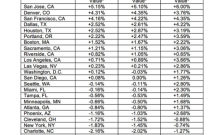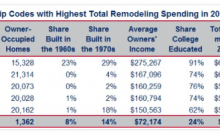Inventory Concerns Limit Sales Contracts
Inventory Concerns Limit Sales Contracts
DAILY NEWS
Pending home sales inched up in October, following two consecutive months of declines. But the gains in home sale contracts were mostly centered in the Northeast and Western regions of the U.S., which offset declines in the Midwest and South last month, according to the National Association of REALTORS®’ Pending Home Sales Index, a forward-looking indicator based on contract signings. Read more: Inventory Relief Coming Soon? Nationwide, NAR’s index edged forward 0.2 percent to a 107.7 reading in October. The index is now 3.9 percent above year ago levels. But Lawrence Yun, NAR’s chief economist, says that pending home sales have plateaued this fall as home purchasers struggle to overcome the shortage of homes available for-sale and prices are rising too quickly in some markets. “Contract signings in October made the most strides in the Northeast, which hasn’t seen much of the drastic price appreciation and supply constraints that are occurring in other parts of the country,” Yun says. “In most competitive metro areas – particularly those in the South and West – affordability concerns remain heightened as low inventory continues to drive up prices.” Contract activity has slightly trended downward since the spring, Yun notes. Of note, “areas that are heavily reliant on oil-related jobs … have already started to see some softness in sales because of declining energy prices,” Yun says. Nevertheless, Yun predicts that nationwide demand will mostly remain stable for the final two months of the year. He predicts that existing-home sales will finish out the year at a pace of 5.30 million – the highest since 2006, according to his 2016 economic outlook and housing forecast. Still, ongoing inventory shortages and affordability pressures from rising prices and mortgage rates will likely temper sales growth to around 3 percent in 2016, according to Yun. Home prices are forecasted to slightly moderate from a 6 percent increase in 2015 to 5 percent next year. “Unless sizeable supply gains occur for new and existing homes, prices and rents will continue to exceed wages into next year and hamstring a large pool of potential buyers trying to buy a home,” Yun says. Source: National Association of REALTORS®
Pending home sales inched up in October, following two consecutive months of declines. But the gains in home sale contracts were mostly centered in the Northeast and Western regions of the U.S., which offset declines in the Midwest and South last month, according to the National Association of REALTORS®’ Pending Home Sales Index, a forward-looking indicator based on contract signings.
Read more: Inventory Relief Coming Soon?
Nationwide, NAR’s index edged forward 0.2 percent to a 107.7 reading in October. The index is now 3.9 percent above year ago levels.
But Lawrence Yun, NAR’s chief economist, says that pending home sales have plateaued this fall as home purchasers struggle to overcome the shortage of homes available for-sale and prices are rising too quickly in some markets.
“Contract signings in October made the most strides in the Northeast, which hasn’t seen much of the drastic price appreciation and supply constraints that are occurring in other parts of the country,” Yun says. “In most competitive metro areas – particularly those in the South and West – affordability concerns remain heightened as low inventory continues to drive up prices.”
Contract activity has slightly trended downward since the spring, Yun notes. Of note, “areas that are heavily reliant on oil-related jobs … have already started to see some softness in sales because of declining energy prices,” Yun says.
Nevertheless, Yun predicts that nationwide demand will mostly remain stable for the final two months of the year. He predicts that existing-home sales will finish out the year at a pace of 5.30 million – the highest since 2006, according to his 2016 economic outlook and housing forecast.
Still, ongoing inventory shortages and affordability pressures from rising prices and mortgage rates will likely temper sales growth to around 3 percent in 2016, according to Yun. Home prices are forecasted to slightly moderate from a 6 percent increase in 2015 to 5 percent next year.
“Unless sizeable supply gains occur for new and existing homes, prices and rents will continue to exceed wages into next year and hamstring a large pool of potential buyers trying to buy a home,” Yun says.


